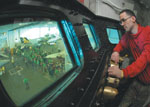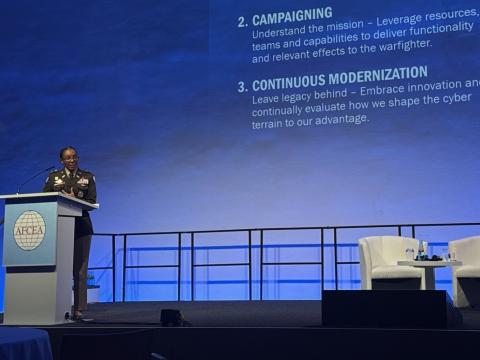Connecting In the Pacific
 |
 |
| Airman Marcos Pagan, USAF (t), stands watch in Conflagration Station Three aboard the Nimitz-class aircraft carrier USS Abraham Lincoln while the ship performs a foreign-object damage walkdown in the hangar bays. Arturo Gonzales, Peruvian Navy (b), crew member aboard the Lupo-class frigate BAP Mariátegui, stands watch from the Combat Information Center during Rim of the Pacific (RIMPAC) 2006. The Combined Enterprise Regional Information Exchange System’s Cooperative Maritime Forces Pacific network allowed all the participating ships’ watch officers and commanding officers to access the same information as the other ships and groundstations. |
Communicating through a new community of interest network, coalition forces from eight countries examined information-sharing issues such as language and interoperability during a recent exercise in the
Troops from the
These countries faced the challenge of enabling troops to interoperate throughout the exercise. Command, control, communications and computers (C4) planners addressed this issue by developing a variety of plans and goals. Their primary aim was to have all participants use a single Internet protocol-based secure enclave. Planners met this objective by implementing the Cooperative Maritime Forces Pacific (CMFP) network, a new community of interest network on an existing enclave within the Combined Enterprise Regional Information Exchange System (CENTRIXS). The exchange system is analogous to the Internet but on a much smaller scale, and it can be accessed only at particular workstations with specific encryption.
“The exercise brought units from the eight nations into a coalition framework controlled by common rules of engagement and managed through a single network—the CMFP network,” says Cdre. A. Bruce Donaldson, CF, deputy commander, Combined Task Force, RIMPAC 2006. “It was a significant step in the right direction and set the stage for ongoing coalition exercises and operations in the Asia-Pacific region.”
Ships and shore stations in the exercise were equipped with CENTRIXS CMFP, and participants used it successfully for exercise collaboration and data transfer requirements including Web, e-mail and chat services as well as for viewing a common operational picture. Some stations received only a temporary installation through a CENTRIXS flyaway kit. Each kit included a laptop with the necessary software, a router and enough cable to connect to the ship’s satellite system. The hub of all the different CENTRIXS enclaves resides in servers in
CMFP is a small segment of CENTRIXS on which all the partner countries could participate. It lays the groundwork for more rapid, closer to real-time sharing of critical warfighting information. RIMPAC 2006 was the first time CMFP was used on a wide scale.
U.S. C4 planners were pleased with the success of the community of interest network. “CMFP has to be labeled the biggest success [of RIMPAC],” states Lt. Cmdr. Vince Augelli, USN, lead C4 and intelligence planner for RIMPAC. “We heard concurring opinions from most of the flag officers involved in the exercise.”
According to Cmdr. Augelli, the
CENTRIXS has other security enclaves as well. For example, the
CMFP allowed all RIMPAC participants to have a complete operational picture. In the past, other countries commented that the
Even
With CMFP, the commanding officer or watch officer of all the ships involved had the same information as the forces in
To ensure communications security on the system, countries had to monitor the information they released and their security codes. For example, codes normally used by
U.S. RIMPAC officials say CMFP’s performance across the board was surprisingly successful. The militaries used it as their primary tool for operations and for troubleshooting communications equipment. When a ship already underway had problems with a voice radio, technicians worked on the problem using the CMFP chat function. The system was reliable enough that backup data paths were rarely used after initial communications checks.
In addition to ensuring technical compatibility, the coalition partners had to overcome cultural barriers, including language. To address this problem, all personnel used common English in the chat rooms dedicated to users with specific requirements such as logisticians.
C4 planning for RIMPAC began 11 months prior to the exercise start date. Officials attended three multiday planning sessions, and principals from all participating countries engaged in ongoing coordination efforts. Final planning and testing, including the installation of communications equipment such as the CENTRIXS flyaway kits, were conducted during the harbor phase week at
Participants also performed significant communications planning efforts outside of CENTRIXS CMFP. While much communication in the exercise was conducted over the computer, the militaries used radios as well. Planners had to manage satellites for message traffic from ships, and each country had national and exercise requirements to meet. To improve interoperability, all coalition partners needed the same cryptographic materials.
Some allies had prior experience with CENTRIXS and had an easy transition to CMFP. Countries with no CENTRIXS backbone required the kits, satellite antenna modifications and more training and preparation.
Communication and interoperability between the
Despite the success of CMFP, Cmdr. Augelli points out that the results from RIMPAC 2006 should not be construed to mean that CMFP equals interoperability. “CMFP enabled the people in different participating units to be interoperable to a degree,” he shares. The commander observes that people and procedures are the greatest barriers to interoperability. However, he adds that the more often different countries take part in one another’s day-to-day missions and operations planning, the better partnerships they will develop.
Some personnel in the exercise had the chance to form closer ties with allies. Several teams of
Participating nations plan to continue using CMFP or similar systems to develop Web pages and to perform other functions throughout the preparation process for future RIMPAC exercises. Funding and accreditation problems prevented this for the 2006 exercise, but officials expect that having the network in place will aid planning for RIMPAC in 2008.
“What we’d love to see happen in RIMPAC 2008 is to have the network there as a planning tool for the full preceding time,” Cmdr. Augelli explains. “That would really be beneficial.”
In addition to the goal to increase coalition interoperability, RIMPAC participants also aimed to enhance key warfighting skill sets. The coalition partners conducted experiments in intelligence, surveillance and reconnaissance as well as meteorology/ oceanography and mine, antisubmarine and surface warfare. Cdre. Donaldson says, “RIMPAC 2006 was an excellent opportunity to enhance coalition capability in the Pacific. The carefully structured exercise included a broad spectrum of operational training. This was focused on individual units but conducted in a realistic, theater-level littoral environment of escalating threat.”
Four additional Pacific nations—
Web Resources
Rim of the Pacific 2006: www.comthirdflt.navy.mil/RIMPAC_2006
Commander, U.S. Third Fleet: www.comthirdflt.navy.mil
Combined




Comments